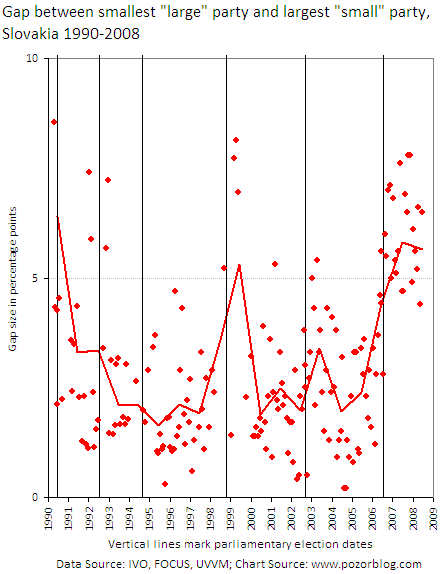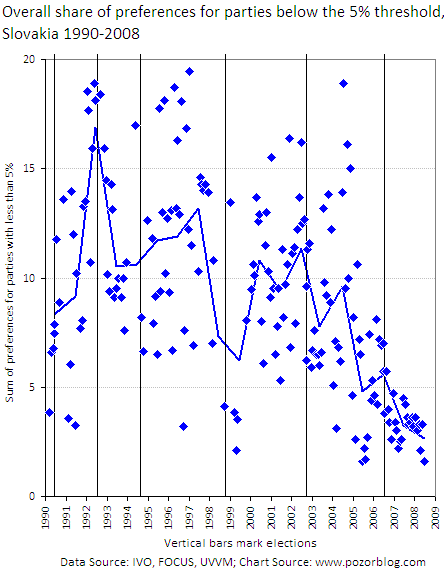A brief note here to comment on one specific element of Robert Fico’s press conference remarks here regarding contracts received by those close to Smer: “the government coalition will not allow discrimination against two-thirds of the population only because they sympathize with the government party.” (see below in red).
This is notable for several reasons,
- first because it is a nice example of the power of the current coalition’s public opinion position as political argument (popularity here becomes a justification for actions) and, within that framework, of a particular interpretation of public opinion. It is certainly fair to say that 2/3 of Slovakia’s current voters support Smer, HZDS or SNS, but to the extent that in any given poll about 30% of voters do not support any party. Of course this is ordinary political use of numbers and nothing particularly unusual or scandalous.
- Second, and I noticed the artfulness only in translating and transcribing, there is the notion of government refusing to permit discrimination. This is a common argument, but it is distinctive here because the prime minister is arguing that he will not permit discrimination against his own supporters. The powerful subtext here, and what allows this to work despite the fact that in the same sentence he notes that he and his coalition partners have a clear supermajority in public opinion, is the spectre of dominant forces other than 2/3 the people who seek to do them harm. I have been noting for some time how well Fico has maintained his anti-establishment position despite having almost sole control of the strongest party (and coalition) in Slovakia’s postcommunist history. Whether he can keep this up is another question (and I have consistently been wrong in predicting that he couldn’t, but that is a question for another post). The key appears to be his ability to persuade others (perhaps because he believes it to be true) that others (media, the former opposition, the United States, foreign investors) are the ones shaping Slovakia’s destiny. Balancing that appeal to weakness with appeals to his own efficacy requires a delicate sense of balance. So far he has proven himself a master.
Nedovolíme diskrimináciu ľudí len preto, že nás podporujú, odkázal médiám Fico
22. augusta 2008 16:28
Premiér Robert Fico sa znovu zastal ministerky práce Viery Tomanovej, ktorá čelí kritike za sporné štátne dotácie ľuďom blízkym jeho strane Smer-SD. Premiér zdôraznil, že nezákonné postupy alebo predražené tendre bude trestať, zároveň však je podľa neho prirodzené, ak sa predstavitelia vlády snažia v súlade so zákonom podporiť obce a mestá, ktoré vedú zástupcovia vládnych strán.Predseda vlády Robert Fico počas tlačovej besedy, na ktorej oznámil, že vládna koalícia nedovolí diskrimináciu dvoch tretín obyvateľov len preto, že sympatizujú s vládnymi stranami.Vládna koalícia nedovolí diskrimináciu dvoch tretín obyvateľov len preto, že sympatizujú s vládnymi stranami, vyhlásil premiér na brífingu, po ktorom nepripustil žiadne otázky. Predseda vlády chcel len novinárom ukázať prípady “straníckeho klientelizmu” vo fungovaní americkej demokracie a aj tak ich presvedčiť, že za dotáciami svojim nie je nič nemorálne.
Kritiku za podporu sociálnych podnikov v oblastiach s vysokou nezamestnanosťou považuje za zvrhlú. Zároveň oznámil, že už viac nebude reagovať na mediálne útoky a rôzne pseudokauzy, ako boli sociálne podniky či verejné obstarávania. “Vy nemôžete nahradiť Úrad pre verejné obstarávanie,” povedal médiám.
Fico: Nenecháme sa terorizovať médiami
Zdroj: SITA • 5,14 MB • zaznamenané: 22. 8. 2008Ministerstvo práce podľa tlače pridelilo spolu asi 500 miliónov korún (16,6 milióna eur) na budovanie takzvaných sociálnych podnikov spoločnostiam, s ktorými sú spojení poslanci a členovia premiérovej strany. Tomanová (Smer-SD) však nedávno odmietla úvahy, že žiadatelia ťažili so svojich kontaktov s najsilnejšou vládnou stranou. Sociálne podniky by mali pomáhať znižovať nezamestnanosť. Určené sú napríklad pre ľudí, ktorí sú bez práce dlhodobo.
“Nebudeme považovať za neprípustné, ak napríklad v prípade dvoch rovnocenných projektov s rovnakou kvalitou a rovnakým výsledným efektom člen vlády uprednostní starostu či primátora za vládnu koalíciu,” vyhlásil Fico. Podmienkou podľa neho však je, aby nebol porušený zákon.
Ministerka Tomanová už v minulosti čelila výhradám za vyplatenie štátnej podpory Centru privátnych sociálnych služieb Privilégium napriek tomu, že na ňu nemalo nárok. Za sporné dotácie z verejných zdrojov nedávno musel na žiadosť premiéra odísť Jaroslav Izák (SNS) z postu ministra životného prostredia. Predražené tendre zas stáli miesto ministra obrany Františka Kašického zo Smeru-SD.
Nedovolíme diskrimináciu ľudí len preto, že nás podporujú, odkázal médiám Fico – Pravda.sk – Flock


